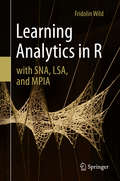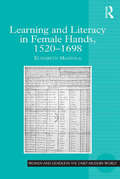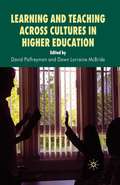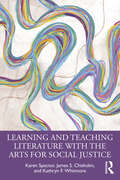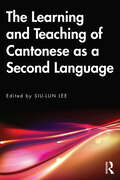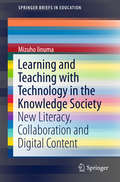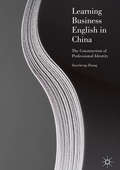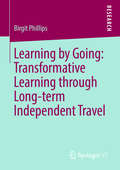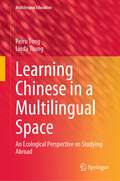- Table View
- List View
Learning Analytics in R with SNA, LSA, and MPIA
by Fridolin WildThis book introduces Meaningful Purposive Interaction Analysis (MPIA) theory, which combines social network analysis (SNA) with latent semantic analysis (LSA) to help create and analyse a meaningful learning landscape from the digital traces left by a learning community in the co-construction of knowledge. The hybrid algorithm is implemented in the statistical programming language and environment R, introducing packages which capture – through matrix algebra – elements of learners’ work with more knowledgeable others and resourceful content artefacts. The book provides comprehensive package-by-package application examples, and code samples that guide the reader through the MPIA model to show how the MPIA landscape can be constructed and the learner’s journey mapped and analysed. This building block application will allow the reader to progress to using and building analytics to guide students and support decision-making in learning.
Learning and Literacy in Female Hands, 1520-1698 (Women and Gender in the Early Modern World)
by Elizabeth MazzolaFocusing on the unusual learning and schooling of women in early modern England, this study explores how and why women wrote, the myriad forms their alphabets could assume, and the shape which vernacular literacy acquired in their hands. Elizabeth Mazzola argues that early modern women's writings often challenged the lessons of their male teachers, since they were designed to conceal rather than reveal women's learning and schooling. Employed by early modern women with great learning and much art, such difficult or ’resistant’ literacy organized households and administrative offices alike, and transformed the broader history of literacy in the West. Chapters treat writers like Jane Sharp, Anne Southwell, Jane Seager, Martha Moulsworth, Elizabeth Tudor, and Katherine Parr alongside images of women writers presented by Shakespeare and Sidney. Managing women's literacy also concerned early modern statesmen and secretaries, writing masters and grammarians, and Mazzola analyzes how both the emerging vernacular and a developing bureaucratic state were informed by these contests over women's hands.
Learning and Literacy in Female Hands, 1520-1698 (Women and Gender in the Early Modern World)
by Elizabeth MazzolaFocusing on the unusual learning and schooling of women in early modern England, this study explores how and why women wrote, the myriad forms their alphabets could assume, and the shape which vernacular literacy acquired in their hands. Elizabeth Mazzola argues that early modern women's writings often challenged the lessons of their male teachers, since they were designed to conceal rather than reveal women's learning and schooling. Employed by early modern women with great learning and much art, such difficult or ’resistant’ literacy organized households and administrative offices alike, and transformed the broader history of literacy in the West. Chapters treat writers like Jane Sharp, Anne Southwell, Jane Seager, Martha Moulsworth, Elizabeth Tudor, and Katherine Parr alongside images of women writers presented by Shakespeare and Sidney. Managing women's literacy also concerned early modern statesmen and secretaries, writing masters and grammarians, and Mazzola analyzes how both the emerging vernacular and a developing bureaucratic state were informed by these contests over women's hands.
Learning and Literacy over Time: Longitudinal Perspectives
by Julian Sefton-Green Jennifer RowsellLearning and Literacy over Time addresses two gaps in literacy research—studies offering longitudinal perspectives on learners and the trajectory of their learning lives inside and outside of school, and studies revealing how past experiences with literacy and learning inform future experiences and practices. It does so by bringing together researchers who revisited subjects of their initial research conducted over the past 10-20 years with people whom they encountered through ethnographic or classroom-based investigations and are the subjects of previous published accounts. The case studies, drawn from countries in three continents and covering a range of social worlds, offer an original and at times quite an emotive interpretation of the effects of long-term social change in the UK, the US, Australia and Canada; the claims and aspirations made by and for certain kinds of educational interventions; how research subjects reflect on and learn from the processes of being co-opted into classroom research as well as how they make sense of school experiences; some of the widespread changes in literacy practices as a result of our move into the digital era; and above all, how academic research can learn from these life stories raising a number of challenges about methodology and our claims to 'know’ the people we research. In many cases the process of revisiting led to important reconceptualizations of the earlier work and a sense of 'seeing with new eyes’ what was missed in the past. The reflections on methodology and research processes will interest postgraduate and academic researchers. The studies of change and of long-term effects are widely relevant to teacher educators and scholars in language and literacy education, educational anthropology, life history research, media and cultural studies, and sociology.
Learning and Literacy over Time: Longitudinal Perspectives
by Julian Sefton-Green Jennifer RowsellLearning and Literacy over Time addresses two gaps in literacy research—studies offering longitudinal perspectives on learners and the trajectory of their learning lives inside and outside of school, and studies revealing how past experiences with literacy and learning inform future experiences and practices. It does so by bringing together researchers who revisited subjects of their initial research conducted over the past 10-20 years with people whom they encountered through ethnographic or classroom-based investigations and are the subjects of previous published accounts. The case studies, drawn from countries in three continents and covering a range of social worlds, offer an original and at times quite an emotive interpretation of the effects of long-term social change in the UK, the US, Australia and Canada; the claims and aspirations made by and for certain kinds of educational interventions; how research subjects reflect on and learn from the processes of being co-opted into classroom research as well as how they make sense of school experiences; some of the widespread changes in literacy practices as a result of our move into the digital era; and above all, how academic research can learn from these life stories raising a number of challenges about methodology and our claims to 'know’ the people we research. In many cases the process of revisiting led to important reconceptualizations of the earlier work and a sense of 'seeing with new eyes’ what was missed in the past. The reflections on methodology and research processes will interest postgraduate and academic researchers. The studies of change and of long-term effects are widely relevant to teacher educators and scholars in language and literacy education, educational anthropology, life history research, media and cultural studies, and sociology.
Learning and Persuasion in the German Middle Ages: The Call to Judgment (Garland Studies in Medieval Literature #Vol. 15)
by Ernst Ralf HintzFirst published in 1997. Routledge is an imprint of Taylor & Francis, an informa company.
Learning and Persuasion in the German Middle Ages: The Call to Judgment (Garland Studies in Medieval Literature)
by Ernst Ralf HintzFirst published in 1997. Routledge is an imprint of Taylor & Francis, an informa company.
Learning and Teaching Across Cultures in Higher Education
by D. Palfreyman D. McBrideLearning and Teaching Across Cultures in Higher Education contains theoretical rationale, resources and examples to help readers understand and deal with situations involving contact between learners or educators from different cultural backgrounds, as well as giving insights into the new global context of higher education.
Learning and Teaching Chinese as a First Language: International Perspectives (The Routledge Series on Chinese Language Education)
by Lee, John Chi-Kin Chung Mou Si Lam, Sin Manw SophiaIn this book, the authors embark on a critical investigation of the complex field of Chinese language education, with a particular focus on exploring new trends and teaching and learning. They delve into the intricacies of language, education and its effectiveness in teaching Chinese as a first language.The book has three objectives: establishing a field of study in Chinese language learning and teaching, providing critical discussion and progressive insights on language education, and offering relevant pedagogical perspectives of learning and teaching Chinese as L1 and L2. The chapters investigate learning and teaching of Chinese in different aspects, including four skills, culture, literature, technology-assisted learning, and learners’ identity. By focusing on the teaching practices of Chinese at different levels, it sheds light on teaching Chinese as a first language. Theoretically, it broadens the linguistic and geographical reach of previous works on language education that mainly examine English as a lingua franca or children’s first language acquisition. Drawing upon theories in language learning, the book demonstrates the applicability of language theories in the first language and Chinese as a non-alphabetic language and examines the impact and effectiveness of some theories in Chinese learning and teaching.Academic researchers, teacher educators, teachers and students interested in Chinese language and education will find this a highly relevant text for its focus on curriculum, pedagogy and assessment of teaching Chinese as a first language.
Learning and Teaching Chinese as a First Language: International Perspectives (The Routledge Series on Chinese Language Education)
In this book, the authors embark on a critical investigation of the complex field of Chinese language education, with a particular focus on exploring new trends and teaching and learning. They delve into the intricacies of language, education and its effectiveness in teaching Chinese as a first language.The book has three objectives: establishing a field of study in Chinese language learning and teaching, providing critical discussion and progressive insights on language education, and offering relevant pedagogical perspectives of learning and teaching Chinese as L1 and L2. The chapters investigate learning and teaching of Chinese in different aspects, including four skills, culture, literature, technology-assisted learning, and learners’ identity. By focusing on the teaching practices of Chinese at different levels, it sheds light on teaching Chinese as a first language. Theoretically, it broadens the linguistic and geographical reach of previous works on language education that mainly examine English as a lingua franca or children’s first language acquisition. Drawing upon theories in language learning, the book demonstrates the applicability of language theories in the first language and Chinese as a non-alphabetic language and examines the impact and effectiveness of some theories in Chinese learning and teaching.Academic researchers, teacher educators, teachers and students interested in Chinese language and education will find this a highly relevant text for its focus on curriculum, pedagogy and assessment of teaching Chinese as a first language.
Learning and Teaching in Higher Education: Policy Discourses and the Illusion of Best Practice
by Sarah HorrodThis book explores the discourses in learning and teaching policy in UK higher education, traces how these ideas are recontextualised at institutional level and reveals the differences between policy discourses and lecturers’ and students’ experiences. The author argues that policy ideas around learning and teaching are not simply value-free ‘best practice’ but reflect the socio-political context of higher education. The study uses an innovative conceptual framework of critical discourse studies (CDS) and Bernstein’s sociology of pedagogy to provide critical lenses to uncover the underlying messages of policy. The book will interest a wide academic audience including anyone involved in higher education globally.
Learning and Teaching Literature with the Arts for Social Justice
by Karen Spector James S. Chisholm Kathryn F. WhitmoreThis text invites pre-service teachers to explore arts-informed practices that showcase the transformative potential of literature in the classroom. Through the lens of "stories-we-live-by," the authors recognize literature as interference, capable of disrupting the habitual patterns through which we interpret the world in order to reawaken the capacity of students and teachers alike to change. Chapters are designed to inspire students’ love of literature by fostering literary and artful encounters that provoke their thinking and sense-making. Each chapter includes engaging pedagogical features that spark thinking and analysis of literature and invite readers to further engagement. The appendices include directions for instruction as well as additional resources. An essential text for courses on children’s and adolescent literature and English methods, pre-service teachers will come away with plenty of text recommendations and arts- and social justice-informed practices to use with their future students. Through artful encounters with visual learning analyses, visual-verbal journals, drama, soundscapes, poetry, and so much more, readers examine their own transformative experiences with literature. Readers will learn to craft and curate practices that encourage engagement, imagination, experimentation, and self-awareness in and beyond the classroom.
Learning and Teaching Literature with the Arts for Social Justice
by Karen Spector James S. Chisholm Kathryn F. WhitmoreThis text invites pre-service teachers to explore arts-informed practices that showcase the transformative potential of literature in the classroom. Through the lens of "stories-we-live-by," the authors recognize literature as interference, capable of disrupting the habitual patterns through which we interpret the world in order to reawaken the capacity of students and teachers alike to change. Chapters are designed to inspire students’ love of literature by fostering literary and artful encounters that provoke their thinking and sense-making. Each chapter includes engaging pedagogical features that spark thinking and analysis of literature and invite readers to further engagement. The appendices include directions for instruction as well as additional resources. An essential text for courses on children’s and adolescent literature and English methods, pre-service teachers will come away with plenty of text recommendations and arts- and social justice-informed practices to use with their future students. Through artful encounters with visual learning analyses, visual-verbal journals, drama, soundscapes, poetry, and so much more, readers examine their own transformative experiences with literature. Readers will learn to craft and curate practices that encourage engagement, imagination, experimentation, and self-awareness in and beyond the classroom.
The Learning and Teaching of Cantonese as a Second Language
by Siu-Lun LeeThe Learning and Teaching of Cantonese as a Second Language brings together contributions on such issues as Cantonese textbooks, linguistic description, literacy and tone acquisition, supplemented by case studies from the Netherlands and Japan. The learning and teaching of Cantonese as a second language is a subject of considerable interest in the international academic community, and the first international symposium on teaching Cantonese as a second language, held at the Chinese University of Hong Kong in October 2019, brought together leading researchers in this field. This conference provided the inspiration for the current volume, The Learning and Teaching of Cantonese as a Second Language. In the Hong Kong context, historically, the term ‘Cantonese’ refers to the language varieties of immigrants who came to the territory from various areas in Guangdong province, including Macau, Panyu, Taishan, Xinhui and Zhongshan. From the late nineteenth century onwards, their speech coalesced into the contemporary variety of Cantonese used in Hong Kong today. The term ‘Cantonese’ is also used to refer to the entire Yue subgroup of Chinese, which includes varieties of Cantonese spoken in southern China, Hong Kong, Macau, Malaysia, Singapore and among overseas Chinese in Australia, Europe and North America. In all, it is estimated that there are about 70 million Cantonese speakers in the world. This volume is of direct relevance to educators, language teachers, linguists and all those concerned with the learning of Cantonese as a second language.
The Learning and Teaching of Cantonese as a Second Language
The Learning and Teaching of Cantonese as a Second Language brings together contributions on such issues as Cantonese textbooks, linguistic description, literacy and tone acquisition, supplemented by case studies from the Netherlands and Japan. The learning and teaching of Cantonese as a second language is a subject of considerable interest in the international academic community, and the first international symposium on teaching Cantonese as a second language, held at the Chinese University of Hong Kong in October 2019, brought together leading researchers in this field. This conference provided the inspiration for the current volume, The Learning and Teaching of Cantonese as a Second Language. In the Hong Kong context, historically, the term ‘Cantonese’ refers to the language varieties of immigrants who came to the territory from various areas in Guangdong province, including Macau, Panyu, Taishan, Xinhui and Zhongshan. From the late nineteenth century onwards, their speech coalesced into the contemporary variety of Cantonese used in Hong Kong today. The term ‘Cantonese’ is also used to refer to the entire Yue subgroup of Chinese, which includes varieties of Cantonese spoken in southern China, Hong Kong, Macau, Malaysia, Singapore and among overseas Chinese in Australia, Europe and North America. In all, it is estimated that there are about 70 million Cantonese speakers in the world. This volume is of direct relevance to educators, language teachers, linguists and all those concerned with the learning of Cantonese as a second language.
The Learning and Teaching of Phonological Decoding in Chinese EFL Children
by Keren HuaThis book presents the learning and teaching of phonological decoding in Chinese EFL primary classrooms. The phonological decoding ability of the children is described, interpreted, and evaluated, the teaching materials are analyzed and the classroom instruction observed, and the links between these various facets are explored using both quantitative and qualitative techniques (textbook analysis, classroom observations, interviews with teachers and a textbook writer, reading test and nonword reading test). This book provides insights into Chinese children’s phonological decoding profile, including performance in decoding different types of orthographic units, the strategies children at different levels of reading ability use to sound out vowel graphemes, and their decoding ability in relation to reading ability. The investigation of the teaching practices reveals how the decoding instruction is designed, developed, and delivered to the children and thereby informs the interplay between the classroom instruction and children’s development of phonological decoding skills.
Learning and Teaching with Technology in the Knowledge Society: New Literacy, Collaboration and Digital Content (SpringerBriefs in Education #0)
by Mizuho IinumaThis book discusses learning and teaching with modern technology in the new knowledge society. It focuses specifically on new literacy and technology in classroom environments. Based on a social-constructivist approach, this book covers a wide range of new technology use examples, such as participatory media, video recording systems and 3D computer graphics. A case study on a constructivist approach to teaching and learning, especially CSCL (computer supported collaborative learning), is discussed from a practical perspective for educators. It also includes specific in-class practices with detailed accounts of curricula featuring readily accessible yet new technology available for classroom use, such as Google Sketchup 3D computer models.
Learning and Using Languages in Ethnographic Research (Researching Multilingually #2)
by Robert Gibb Annabel Tremlett Julien Danero IglesiasLearning and Using Languages in Ethnographic Research breaks the silence that still surrounds learning a language for ethnographic research and in the process demystifies some of the multilingual aspects of contemporary ethnographic work. It does this by offering a set of engaging and accessible accounts of language learning and use written by ethnographers who are at different stages of their academic career. A key theme is how researchers’ experiences of learning and using other languages in fieldwork contexts relate to wider structures of power, hierarchy and inequality. The volume aims to promote a wider debate among researchers about how they themselves learn and use different languages in their work, and to help future fieldworkers make more informed choices when carrying out ethnographic research using other languages.
Learning Business English in China: The Construction of Professional Identity
by Zuocheng ZhangThis book analyses the learning experiences of students of Business English at a Chinese university. It addresses several topical issues in English for Specific Purposes (ESP) education and Business English teaching, including how ESP students learn, how they develop multiple identities. In particular, it focuses on their professional identity in the classroom, and how these identities are transferred to the workplace. This allows the author to present a model of learning Business English that corresponds to the lived experiences of students in China, but which can also be applied to other ESP learner contexts. In doing so, he demonstrates how to research the professional identity of ESP learners from multiple perspectives, and contributes to the validity of research on language learning and learner identity. This book will appeal to scholars of English for Specific Purposes, Second Language Acquisition, and TESOL Education.
Learning Business English in China: The Construction of Professional Identity
by Zuocheng ZhangThis book analyses the learning experiences of students of Business English at a Chinese university. It addresses several topical issues in English for Specific Purposes (ESP) education and Business English teaching, including how ESP students learn, how they develop multiple identities. In particular, it focuses on their professional identity in the classroom, and how these identities are transferred to the workplace. This allows the author to present a model of learning Business English that corresponds to the lived experiences of students in China, but which can also be applied to other ESP learner contexts. In doing so, he demonstrates how to research the professional identity of ESP learners from multiple perspectives, and contributes to the validity of research on language learning and learner identity. This book will appeal to scholars of English for Specific Purposes, Second Language Acquisition, and TESOL Education.
Learning by Going: Transformative Learning through Long-term Independent Travel
by Birgit PhillipsBirgit Phillips explores the concept of transformative travel as it pertains to long-term independent travelers and offers a broad philosophical understanding of the complex socio-cultural processes involved in identity negotiation. She examines both the elements that contribute to the transformation of values and identities and the mechanisms by which this transformation occurs. By deploying a pluralistic, reflexive, interpretive research approach, Phillips foregrounds the personal experiences of the individual study participants and the meanings they attach to their travel experiences. In addition, since the study spanned over 14 years, the author is able to provide a wide-ranging picture of the complete travel experience, from initial motivations to post-travel reintegration as well as the long-term effects on traveler values and identities.
Learning Chinese in a Multilingual Space: An Ecological Perspective on Studying Abroad (Multilingual Education #41)
by Peiru Tong Linda TsungThis book examines the benefits of an Australian in-country study (ICS) in China programme and explores ways to maximise the short-term ICS experience in a multilingual space. The book employs an ecological perspective which has seldom been used to examine the study abroad context. It emphasises the importance of the space itself as an arena of interaction, belonging and power, where conduct and modes of communication are often regulated by political authorities and societal expectations. Specifically, the book focuses on the following: • the extent to which the ICS facilitated interaction in different settings • the way in which interaction during ICS contributed to language learning • the degree in which the interaction during ICS contributed to culture learning and • the role of identity in the learning process in the ICS. The main argument of the book is that while the ICS promoted multilingual learning space for in-class and out-of-class interactions, which further facilitated language and culture learning to a great extent, Australian students’ identities and self-concepts also played a core mediating role throughout individual learning trajectories.
Learning Chinese, Turning Chinese: Challenges to Becoming Sinophone in a Globalised World (Asia's Transformations)
by Edward McDonaldIn this book Edward McDonald takes a fresh look at issues of language in Chinese studies. He takes the viewpoint of the university student of Chinese with the ultimate goal of becoming 'sinophone': that is, developing a fluency and facility at operating in Chinese-language contexts comparable to their own mother tongue. While the entry point for most potential sinophones is the Chinese language classroom, the kinds of "language" and "culture" on offer there are rarely questioned, and the links between the forms of the language and the situations in which they may be used are rarely drawn. The author’s explorations of Chinese studies illustrate the crucial link between becoming sinophone and developing a sinophone identity – learning Chinese and turning Chinese. Including chapters on: relating text to context in learning Chinese the social and political contexts of language learning myths about Chinese characters language reform and nationalism in modern China critical discourse analysis of popular culture ethnicity and identity in language learning. This book will be invaluable for all Chinese language students and teachers, and those with an interest in Chinese linguistics, linguistic anthropology, critical discourse analysis, and language education. Edward McDonald is currently Lecturer in Chinese at the University of Auckland, and has taught Chinese language, music, linguistics and semiotics at universities in Australia, China, and Singapore.
Learning Chinese, Turning Chinese: Challenges to Becoming Sinophone in a Globalised World (Asia's Transformations)
by Edward McDonaldIn this book Edward McDonald takes a fresh look at issues of language in Chinese studies. He takes the viewpoint of the university student of Chinese with the ultimate goal of becoming 'sinophone': that is, developing a fluency and facility at operating in Chinese-language contexts comparable to their own mother tongue. While the entry point for most potential sinophones is the Chinese language classroom, the kinds of "language" and "culture" on offer there are rarely questioned, and the links between the forms of the language and the situations in which they may be used are rarely drawn. The author’s explorations of Chinese studies illustrate the crucial link between becoming sinophone and developing a sinophone identity – learning Chinese and turning Chinese. Including chapters on: relating text to context in learning Chinese the social and political contexts of language learning myths about Chinese characters language reform and nationalism in modern China critical discourse analysis of popular culture ethnicity and identity in language learning. This book will be invaluable for all Chinese language students and teachers, and those with an interest in Chinese linguistics, linguistic anthropology, critical discourse analysis, and language education. Edward McDonald is currently Lecturer in Chinese at the University of Auckland, and has taught Chinese language, music, linguistics and semiotics at universities in Australia, China, and Singapore.
The Learning Commons: Seven Simple Steps to Transform Your Library
by Pam Colburn HarlandThis simple guide provides valuable insights for transforming an out-of-date public, school, or academic library into a thriving, user-centric learning commons.The goal of the learning-commons strategy is to provide a centralized, "go-to" location for all users seeking help on the complex issues of teaching, researching, and being a global citizen in our changing world. A library organized around the learning-commons construct fosters collaborative work and social interaction between users during research and learning. This paradigm also encourages use of innovative technologies and information resources. Transforming a traditional library into a thriving learning commons does take some planning and effort, however.Each of the seven chapters in this book explains a simple step that a librarian can take to improve their facility. Photographs and concrete examples of the suggested strategies are included; checklists at the end of each chapter serve as indicators for measuring progress. This text is useful for library administrators in school settings (both public and private, K-12) as well as academic, public, and special libraries.
